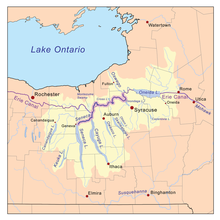| Seneca River | |
|---|---|
 Seneca River above Bonta Bridge in Jordan | |
 Map of the Oswego River basin with the Seneca River highlighted | |
| Location | |
| Country | United States |
| State | New York |
| Physical characteristics | |
| Source | Seneca Lake |
| • location | Geneva, Seneca County |
| • coordinates | 42°52′05″N 76°56′27″W / 42.86806°N 76.94083°W[1] |
| • elevation | 443 ft (135 m)[2] |
| Mouth | Oswego River |
• location | Three Rivers, Onondaga County |
• coordinates | 43°12′05″N 76°16′51″W / 43.20139°N 76.28083°W[1] |
• elevation | 358 ft (109 m)[1] |
| Length | 61.6 mi (99.1 km)[3] |
| Basin size | 3,468 sq mi (8,980 km2)[4] |
| Discharge | |
| • location | USGS gage #4237500 at Baldwinsville[5] |
| • average | 3,501 cu ft/s (99.1 m3/s)[5] |
| • minimum | 34 cu ft/s (0.96 m3/s) |
| • maximum | 22,100 cu ft/s (630 m3/s) |
| Basin features | |
| Tributaries | |
| • left | Clyde River |
| • right | Cayuga Lake, Owasco River, Skaneateles Creek, Onondaga Lake |
The Seneca River flows 61.6 miles (99.1 km)[3] through the Finger Lakes region of Upstate New York in the United States. The main tributary of the Oswego River – the second-largest river flowing into Lake Ontario – the Seneca drains 3,468 square miles (8,980 km2) in parts of fourteen New York counties. The Seneca flows generally east, and is wide and deep with a gentle gradient. Much of the river has been channelized to form part of the Erie Canal.
- ^ a b c "Seneca River". Geographic Names Information System. United States Geological Survey, United States Department of the Interior. 1980-01-23. Retrieved 2014-09-05.
- ^ "Seneca Lake". Geographic Names Information System. United States Geological Survey, United States Department of the Interior. 1980-01-23. Retrieved 2014-09-05.
- ^ a b "The National Map". U.S. Geological Survey. Archived from the original on 2012-03-29. Retrieved Feb 14, 2011.
- ^ "Why is ag. conservation important?". WayneCountyNYsoilandwater.org. Soil and Water Conservation District Wayne County, NY. 19 November 2013. Retrieved December 31, 2015.
- ^ a b "USGS Gage #4237500 on the Seneca River at Baldwinsville, NY" (PDF). National Water Information System. U.S. Geological Survey. 1950–2013. Retrieved 2014-09-05.